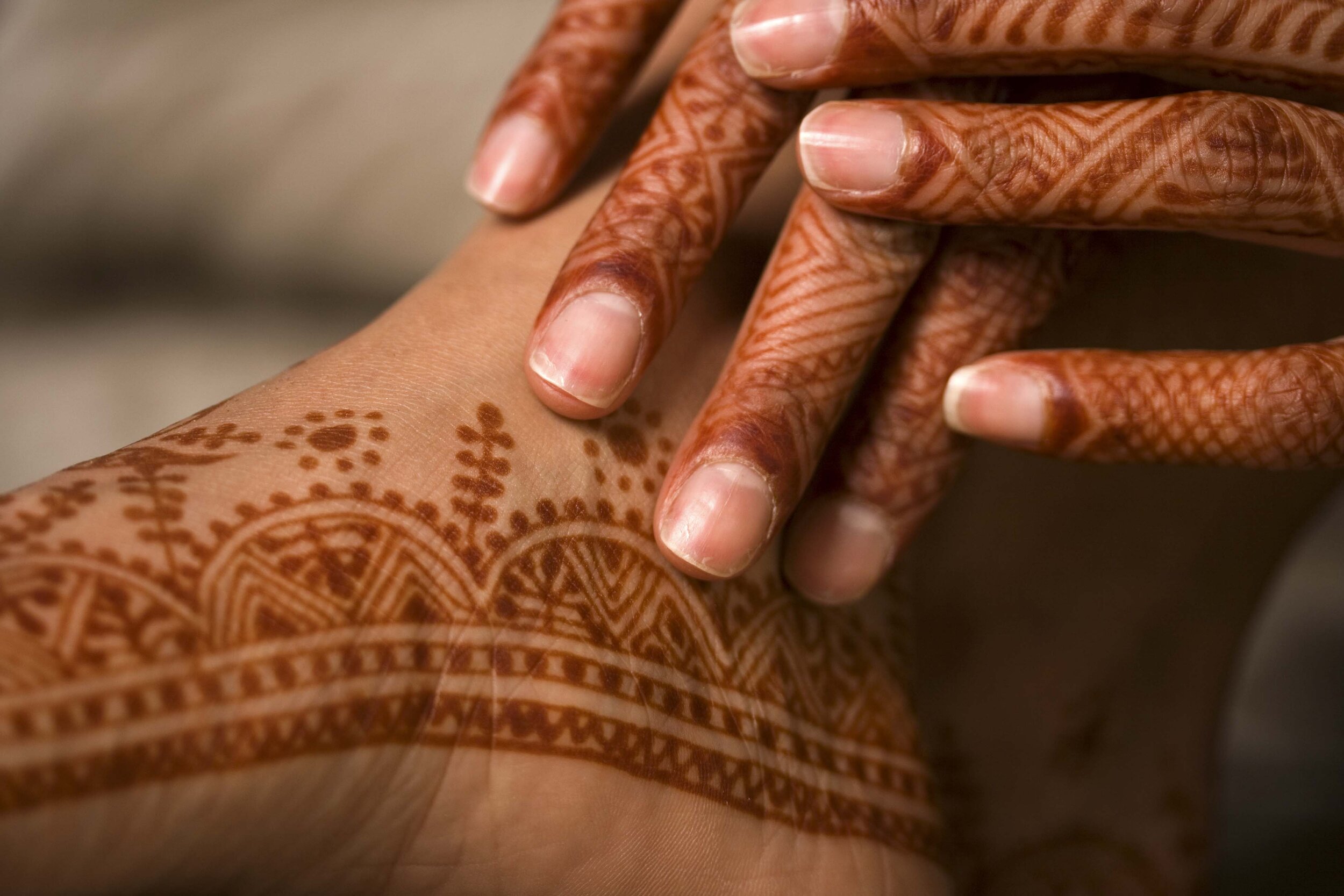OMG it looks like chocolate!!
It's from a plant and goes well with sugar, but henna is not as yummy to eat as chocolate. Henna seems like a miraculous plant—its leaves are green, but the stain they leave is a dark reddish-brown. The layman and the henna artist both see magic. In Morocco, henna is quite literally magic—a plant endowed with supernatural properties that will bring luck and protection to anyone who uses it in any way. But despite its special powers, henna (Latin name Lawsonia inermis) is a humble shrub. Henna plants grow to a height of 3–5 meters (10–16 feet) and can be found all over North Africa, the Middle East, South Asia, Southeast Asia, and beyond.
In addition to its mystical properties, henna has ordinary chemical magic in the form of lawsone, the dye molecule in henna that binds with the protein in the skin (and hair) to produce a reddish-brown color. The greatest amount of lawsone is found in the leaves of the plant, which are dried, ground into a powder, and then sifted for use on skin and hair. The drying process causes the cells to burst, making the lawsone available to bond with the skin and dye it. Henna powder must be fresh, usually no older than 6–12 months. To maintain its freshness, the powder must be kept away from light, heat, and moisture. Those three elements release henna’s dyeing potential—too much of them can make henna stale and incapable of producing a stain. Henna leaves can be picked fresh, crushed, and applied directly to the skin to get a stain, or a paste can be made from the powder and some type of liquid. After the paste is applied, it must remain on the skin for several hours to allow the dye molecules to bind with the skin. Henna stains more quickly and darkly on thicker as opposed to thinner skin; thus, hands and feet stain the best. Moving away from the extremities, henna stains less well.
Take a class!
Who invented henna?
Passionate arguments have been made by various countries claiming to be the birth- place of henna and henna-related arts, but research has concluded that henna’s geographical origin is probably Egypt, whose word for the plant was “henu,” the likely origin of the Arabic word “henna” that is used all over the world. The use of henna to adorn the body is believed to have started in Persia/India. In South Asia, henna is called “mehndi” or variations thereof. In West Africa, it is called “lelli,” and the Tuareg call it “anella.” The Arabic word “henna” has as its root the letters “HNA,” which means “to dye red,” specifically to dye with henna. Persians call it “hinna,” a word derived from the Arabic.
The henna plant is not native to the Maghreb; it probably was introduced by the Arabs through trade—although it is unclear as to when that occurred, possibly when Islam was being introduced to Morocco or even earlier. It is possible to conclude that henna is not indigenous to the Maghreb because there is no Amazigh word for henna among any of the various tribes, while there are Amazigh words for all other native plants. What is curious, however, is that the Tuareg and West Africans do have their own words, which may mean that henna grew naturally in West Africa and was familiar to the Tuareg and West Africans before any contact with traders from the East. There is a belief in the Sahara that henna came from the southeast, not from the north (i.e., North Africa). It is impossible to know for sure.
A henna bush grows in Morocco
The hotter the temperature where henna is grown, the higher the lawsone content of the leaves. Henna grows indigenously in the tropical savanna and tropical arid zone, in latitudes between 15°N and 25°S, from Africa to the western Pacific rim, containing the highest lawsone concentration in areas where temperatures range between 35°C and 45°C (95°–113°F). In Morocco, henna is grown in the Draa Valley in the south. It used to be grown more widely throughout Morocco; but as the country developed, that land was deemed to be more productive for other forms of agriculture. The areas of Morocco hot enough to grow henna are too dry; therefore, successful henna cultivation requires extensive irrigation. Moroccan henna is usually harvested three times a year. The first harvest, at the end of May/beginning of June, is the most sought-after harvest as the leaves are said to give the best color. The leaves are pulled off the branch, not cut; those from the top branches of the plant are thought to have the highest lawsone content. Moroccan henna is grown by cooperatives that sell the dried leaves to a single wholesaler/distributor who then grinds and sifts the henna powder. Moroccan markets sell dried henna leaves and powder by the kilo (loose) or in pre-packed boxes. In the countryside, where only the leaves are available, it is common for women to wait to grind the leaves into powder until immediately before they want to use it.
How do I care for my henna?
Once the henna paste is applied, it needs about a half hour to dry but needs to stay on for a total of 6-12 hours (hands and feet need 6 hours, the rest of the body 8-12 hours). After the waiting time has passed, scrape off the dried paste, and then for the next 6-12 hours, you must keep water off the hennaed skin for the stain to fully take on your skin. Upon removal of the paste, you will see a bright orange stain, which will gradually darken over the next 24-48 hours, turning a deep, rich, reddish-brown color. The stain can last anywhere from 1-3 weeks; it will last longer on the palms of your hands and your feet because the skin is thicker. The stain fades gradually as your skin exfoliates; if you want the stain to last, avoid using anything on the skin that will exfoliate it, and use gloves when doing dishes or housework...or better yet, use your henna as an excuse to avoid cleaning!



